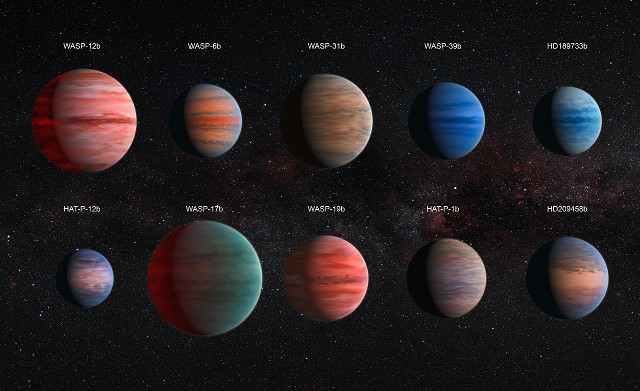
An article published in the journal “Nature” describes a research that provides an explanation to the apparent scarcity of water detected on some exoplanets of the type known as hot Jupiter. These are gas giants like Jupiter but orbit very close to their stars and consequently have very high surface temperatures. An international team of astronomers used the Hubble and Spitzer space telescopes to study ten exoplanets of this kind.
The study of hot Jupiters using the Hubble Space Telescope is difficult because of their proximity to their stars, whose light turns out to be too intense. As a consequence, it allows observations only within a limited range of electromagnetic wavelengths. For this reason, this type of research was limited and the results puzzled researchers. In particular, the analysis of the presence of water in the atmosphere was surprising because it turned out to be lower than expected from existing models.
To overcome the Hubble’s limitation, an international team of astronomers combined its observations with others made with the Spitzer Space Telescope. This allowed to study the atmosphere of ten hot Jupiters in a range of the electromagnetic spectrum that is quite remarkable because it goes from the ultraviolets to the infrareds.
The result of these multiple observations was the largest study of hot Jupiters. The ten planets analyzed have different masses, sizes and temperatures so they make up a representative sample of this kind of planets. Even their atmospheres were diverse, much more than the researchers expected, another interesting result that came from this research.
The in-depth analyzes were made possible using the light of their stars when the planets pass in front of them. In those moments, the light passes through these planets’ atmospheres and when it reaches the Earth carries the “signature” of the elements and molecules existing there.
Spectroscopic analysis of this “signature” allowed to understand which exoplanets have clouds and which don’t. This was important because the atmospheres of the planets that seemed to have little water revealed the presence of clouds and haze. Scientists know that clouds hide the presence of water and this was already one of the theories to explain the low amount detected. This new research confirms that theory.
This study of the hot Jupiters again shows what results can be achieved by combining the power of observation of different instruments. Synergies of this kind are allowing new discoveries and in this case show us that the study of exoplanets is still at the beginning. In the coming years, also with the activation of new telescopes that are more perfected, we can certainly expect many more discoveries.
[ad name=”eBayUSUKAstronomy”]


Permalink